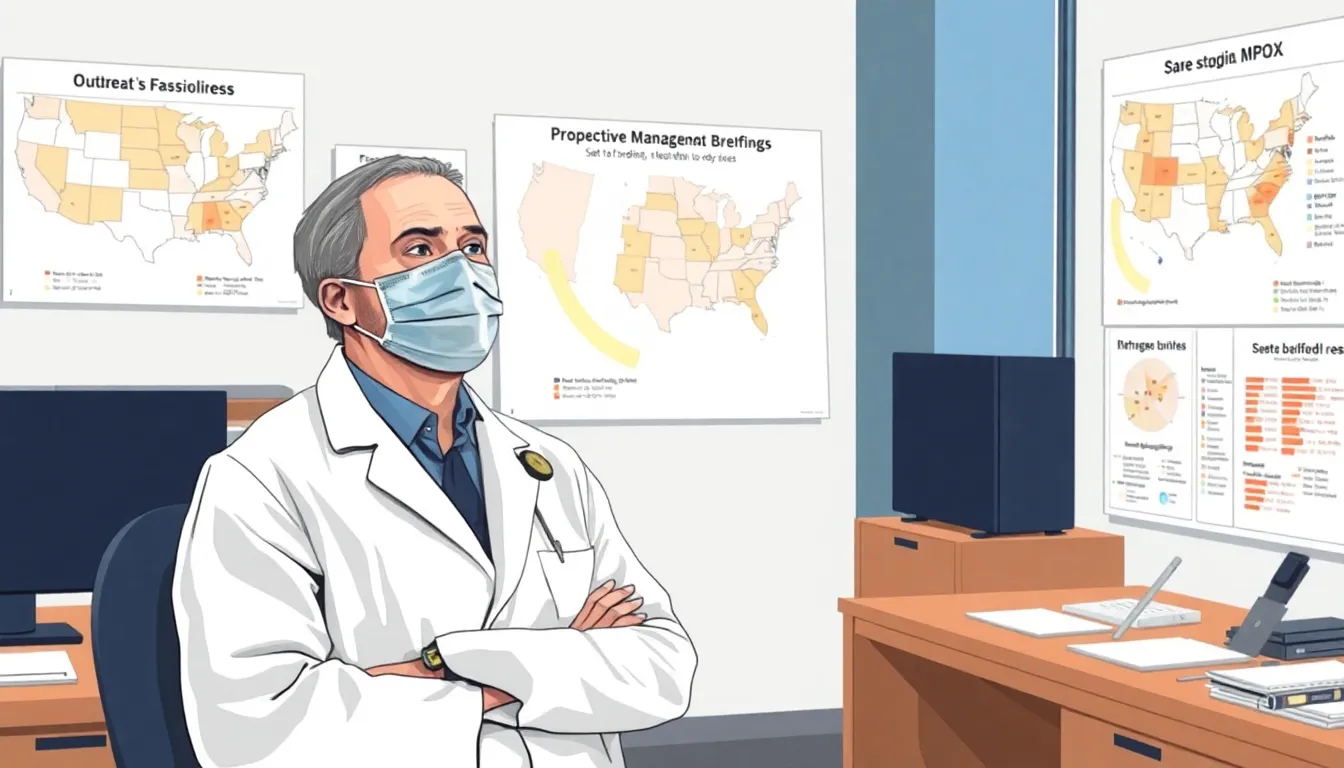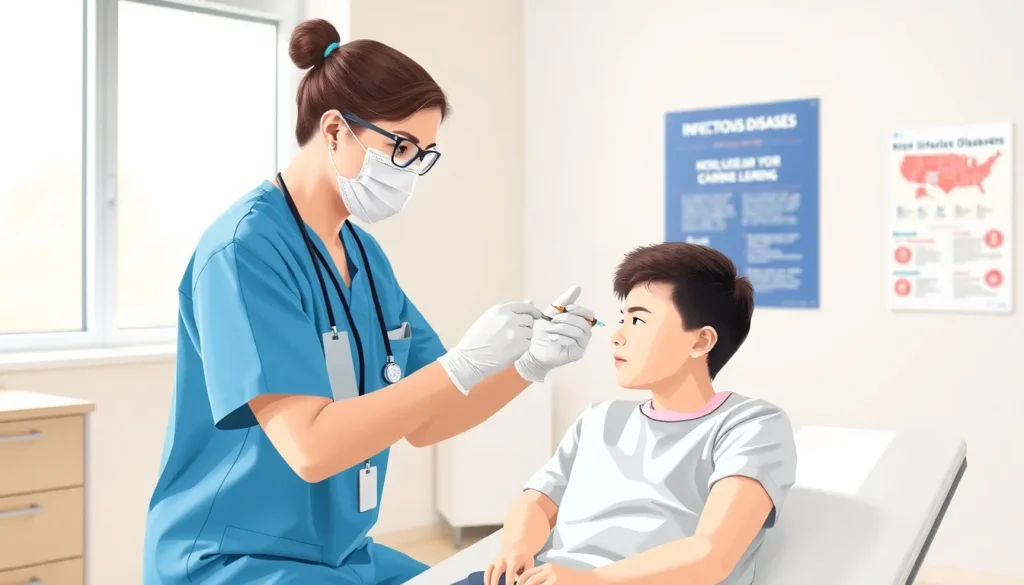Table of Contents
ToggleAs 2024 rolls in, the question on everyone’s lips is: is mpox still lurking in the shadows of the US? With its unexpected emergence in recent years, this viral intruder has turned heads and raised eyebrows. But fear not, the situation is more manageable than a cat meme in a Zoom meeting.
Experts are keeping a close eye on mpox, and while it may not be the life of the party, it’s certainly not gone unnoticed. With ongoing research and public health efforts, understanding mpox has never been more crucial. So buckle up as we dive into the current state of mpox in the US, separating fact from fiction and arming readers with the knowledge they need to stay informed and safe.
Overview of Mpox
Mpox, previously known as monkeypox, is a viral infection that has gained attention due to its recent outbreaks in the United States. The virus belongs to the orthopoxvirus family, which includes smallpox. Initial cases often present with symptoms such as fever, body aches, and swollen lymph nodes. Those infected may also develop a rash that goes through different stages, leading to pus-filled lesions.
Experts recognize the importance of understanding how mpox spreads. Transmission occurs through direct contact with the lesions or bodily fluids of an infected individual. Additionally, respiratory droplets can spread the virus during prolonged face-to-face interactions. This highlights the need for careful monitoring of close contacts during outbreaks.
Public health officials stress that vaccination against mpox can reduce the risk of severe illness. The JYNNEOS vaccine provides protection and is available for at-risk groups. Health departments encourage individuals who may have been exposed to seek vaccination promptly.
As of 2024, mpox cases remain a point of concern. Following the peak of cases in 2022, the situation has stabilized, but vigilance continues. Monitoring trends helps track mpox cases, guiding preventive measures and public health responses.
Educational campaigns play a vital role in raising awareness. Accurate information helps dispel myths and misunderstandings about the disease. Public health resources provide updates on safety protocols, available vaccines, and treatment options, ensuring communities stay informed and safe.
Continued research into mpox is essential for managing future outbreaks. Scientists work diligently to understand the virus’s evolution and improve response strategies. Cooperative efforts among health agencies aim to enhance the broader understanding of this disease, prioritizing community health and safety.
Current Status of Mpox in the US 2024

Mpox continues to be a significant public health concern in the US as 2024 begins. Ongoing efforts focus on managing outbreaks and mitigating risks.
Recent Case Trends
Recent data shows a stabilization in mpox cases after the peak experienced in 2022. The Centers for Disease Control and Prevention (CDC) reports that as of early 2024, there are fewer confirmed cases compared to previous years. The decrease reflects effective vaccination efforts and increased community awareness. Public health officials emphasize the importance of early detection and reporting. Analysis indicates that those vaccinated have a reduced likelihood of severe outcomes, supporting vaccination campaigns tailored to at-risk groups.
Geographic Spread
Geographic spread of mpox in the US shows notable patterns. Most cases remain concentrated in urban areas, particularly in states like New York and California. Health departments monitor these regions closely, implementing localized strategies to contain outbreaks. Remote and rural areas also report sporadic cases, highlighting the need for widespread vaccination efforts. Understanding these patterns aids in prioritizing resources for public health initiatives. Enhanced communication between health agencies and communities ensures timely responses to emerging cases.
Symptoms and Transmission
Mpox presents specific symptoms that can help identify the infection early. Early signs include fever and body aches. Swollen lymph nodes frequently occur. A rash follows, characterized by pus-filled lesions. These symptoms can vary in severity, making awareness essential for timely detection.
Common Symptoms
Symptoms of mpox can develop within 5 to 21 days after exposure. Fever often appears first, accompanied by chills. Additional symptoms include fatigue and muscle aches. Swollen lymph nodes, a unique feature of mpox, may also develop as the infection progresses. A rash typically develops within one to three days following the onset of fever, evolving into lesions that may crust over. Understanding these symptoms aids in prompt diagnosis and public health responses.
How Mpox Spreads
Transmission of mpox primarily occurs through direct contact with infected individuals or their lesions. Bodily fluids, including blood and respiratory droplets, facilitate spread, especially during prolonged interactions. Indirect contact with contaminated materials also poses a risk. Public health officials emphasize close monitoring of affected areas to control outbreaks. Vaccination plays a vital role in protecting high-risk populations. Awareness about these transmission pathways helps curb infection rates effectively.
Prevention and Treatment Options
Vaccination and treatment play pivotal roles in managing mpox effectively. Strategies ensure community safety and minimize the spread of this viral infection.
Vaccination Efforts
Vaccination against mpox, particularly with the JYNNEOS vaccine, remains key for at-risk groups. Health officials target individuals in high-transmission areas to enhance immunity. Reports show that vaccinated individuals benefit from reduced severity if infected. Public health campaigns emphasize awareness of eligibility and accessibility of vaccines. Increased vaccination rates correlate with stabilization of reported cases, highlighting the importance of community participation in vaccination efforts.
Treatment Protocols
Treatment protocols focus on early intervention and symptom management for mpox patients. Antiviral medications, such as tecovirimat (TPOXX), have shown effectiveness in assisting recovery. Symptomatic relief often includes managing fever, pain, and skin lesions. Health providers stress the significance of monitoring symptoms and seeking care promptly. Isolation of confirmed cases prevents further transmission, which is crucial for public health safety. Ongoing research aims to optimize treatment methods as more data becomes available, ensuring readiness for future outbreaks.
Public Health Response
The response to mpox in the US reflects a multi-faceted approach to ensure community safety. Continued efforts target vaccination, treatment, and education.
Government Initiatives
Federal and state governments play crucial roles by implementing health policies designed to combat mpox. Enhanced funding supports vaccination initiatives and research to improve treatment options. Surveillance systems gather invaluable data on case trends, allowing for timely interventions in high-risk areas. Collaborations with healthcare providers ensure that protocols align with the latest public health recommendations. Announcements about vaccine availability and eligibility guidelines frequently appear in community resources, helping to keep the public informed.
Community Awareness Campaigns
Community engagement remains critical for managing mpox effectively. Public health officials launch targeted awareness campaigns, focusing on dispelling misinformation and promoting safe practices. Distribution of educational materials increases knowledge about symptoms, transmission, and vaccination options. Local organizations frequently collaborate with health departments to host informational sessions, enabling community members to ask questions and voice concerns. As awareness grows, individuals are more likely to seek vaccination and report symptoms early, contributing to overall public health efforts.
As 2024 unfolds the situation surrounding mpox in the US shows promising signs of stabilization. Effective vaccination campaigns and increased community awareness have played a crucial role in managing the outbreaks. Public health officials remain vigilant in monitoring trends and emphasizing the importance of early detection and reporting.
Continued education about symptoms and transmission pathways is vital for reducing infection rates. The focus on at-risk groups and accessibility to vaccines like JYNNEOS is essential for maintaining progress. By fostering communication between health agencies and communities the nation can better respond to any emerging cases. Staying informed and proactive will be key in navigating the ongoing challenges posed by mpox.







